
Verticordia acerosa is a flowering plant in the myrtle family, Myrtaceae and is endemic to the south-west of Western Australia. It is a shrub with yellow flowers which change colour through red to almost black as they age. There are two varieties which vary in their leaf shape, their flower colour and some of the structures in the flower.

Kunzea pulchella, commonly known as granite kunzea, is a flowering plant in the myrtle family, Myrtaceae and is endemic to the south-west of Western Australia. It is a shrub with spreading branches, egg-shaped to lance-shaped leaves and loose groups of red flowers, each on a short stalk so that the branch is visible between the flowers.
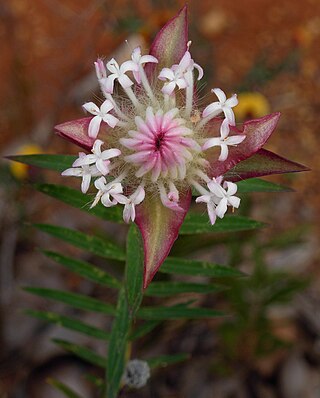
Pimelea spectabilis, or bunjong, is a species of flowering plant in the family Thymelaeaceae and is endemic to the south-west of Western Australia. It is an erect shrub with very narrowly elliptic leaves and heads of white, pale pink or pale yellow flowers surrounded by 4 or 6 egg-shaped involucral bracts.
Calytrix amethystina is a species of flowering plant in the myrtle family Myrtaceae and is endemic to inland areas of Western Australia. It is a glabrous shrub with egg-shaped to oblong or more or less round leaves and clusters of purple to violet flowers with about 35 to 80 white stamens in several rows.
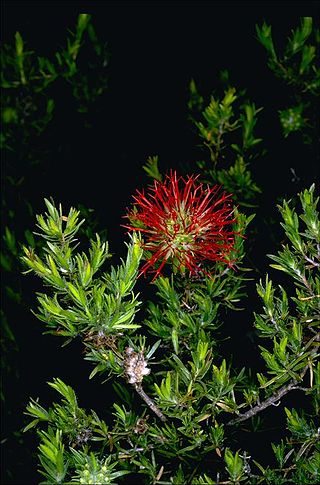
Beaufortia macrostemon, commonly known as Darling Range beaufortia, is a plant in the myrtle family, Myrtaceae and is endemic to the southwest of Western Australia. It is a low shrub with multiple stems, hairy young leaves and three stamens in each stamen bundle.
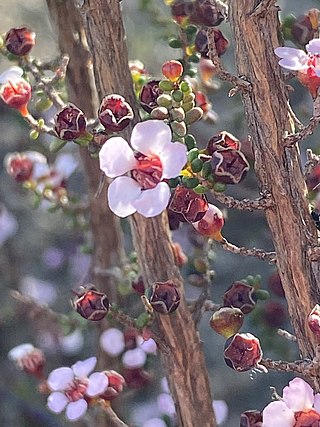
Rinzia orientalis, commonly known as desert heath-myrtle, is a species of flowering plant in the family Myrtaceae and is endemic to south-eastern Australia. It is a shrub with elliptic to narrowly oblong leaves and white or pale pink flowers usually with ten stamens.
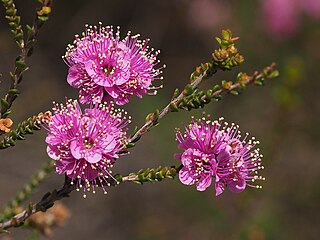
Kunzea rostrata is a species of flowering plant in the myrtle family, Myrtaceae and is endemic to an area along the south west coast of Western Australia. It is a shrub with small, mostly elliptic leaves and with groups of between mostly eleven and fifteen rose pink flowers mainly on the ends of branches that continue to grow after flowering.
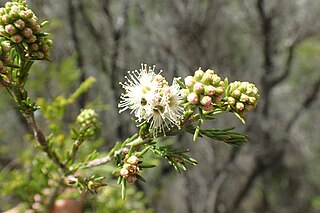
Kunzea spathulata is a species of flowering plant in the myrtle family, Myrtaceae and is endemic to a small area in the south west of Western Australia. It is a tall shrub with erect, much-branched stems, linear leaves and more or less spherical groups of yellow or yellowish green flowers.

Calytrix achaeta, commonly known as the white-flowered turkey bush, kerosene wood or fringe-myrtle, is a species of flowering plant in the myrtle family Myrtaceae and is endemic to north-western Australia. It is a shrub or tree with hairy branchlets, egg-shaped, linear or lance-shaped leaves, and white to cream-coloured flowers with 12 to 18 stamens in a single row.

Calytrix acutifolia is a species of flowering plant in the myrtle family Myrtaceae and is endemic to south-west of Western Australia. It is a slender, openly-branched shrub with linear to lance-shaped leaves and clusters of white, cream-coloured or yellow flowers with 40 to 85 white stamens in several rows.

Calytrix angulata, commonly known as yellow starflower, is a species of flowering plant in the myrtle family Myrtaceae and is endemic to the south-west of Western Australia. It is a shrub with linear to egg-shaped leaves and clusters of yellowish-cream coloured flowers with 30 to 40 yellow stamens in several rows.

Calytrix asperula, commonly known as brush starflower, is a species of flowering plant in the myrtle family Myrtaceae and is endemic to the south of Western Australia. It is a mostly glabrous shrub with linear to narrowly elliptic leaves and cream-coloured to yellow flowers with 40 to 60 yellow stamens in several rows.
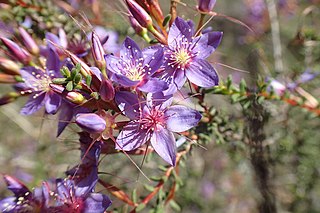
Calytrix violacea is a species of flowering plant in the myrtle family, Myrtaceae and is endemic to the southwest of Western Australia. It is a shrub with linear to narrowly egg-shaped leaves with the narrower end towards the base, and purple, star-shaped flowers.

Micromyrtus triptycha is a species of flowering plant in the family Myrtaceae and is endemic to the south-west of Western Australia. It is an erect, open shrub with narrowly egg-shaped leaves with the narrower end towards the base, and yellow, white or cream-coloured flowers with 10 stamens.
Micromyrtus trudgenii is a species of flowering plant in the family Myrtaceae and is endemic to a small area of inland Western Australia. It is an erect, open shrub with narrowly egg-shaped leaves with the narrower end towards the base, and yellow flowers with 10 stamens.

Baeckea utilis, commonly known as mountain baeckea, is a species of flowering plant in the family Myrtaceae and is endemic to south-eastern continental Australia. It is a shrub with elliptic to lance-shaped leaves with the narrower end towards the base and white flowers, usually with eight stamens.
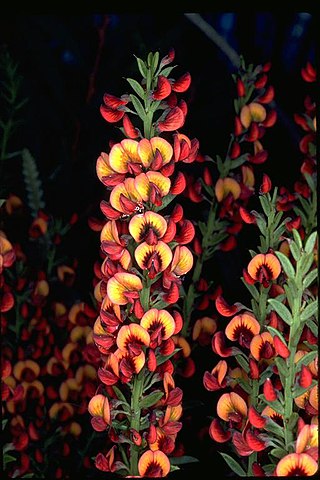
Daviesia polyphylla is a species of flowering plant in the family Fabaceae and is endemic to the south-west of Western Australia. It is a bushy, spreading, glabrous shrub with narrowly egg-shaped or elliptic, sharply-pointed phyllodes and yellow and dark red flowers.

Micromyrtus littoralis is a species of flowering plant in the myrtle family, Myrtaceae and is endemic to south-eastern Queensland. It is a shrub with small, overlapping egg-shaped to lance-shaped leaves, and small white flowers arranged singly in leaf axils with 5 stamens in each flower.

Calytrix alpestris, commonly known as snow-myrtle, is a species of flowering plant in the myrtle family Myrtaceae and is endemic to southern continental Australia. It is a shrub with wiry branchlets, linear to narrowly egg-shaped or narrowly lance-shaped leaves and clusters of white flowers with 14 to 37 white stamens in a single row.

Calytrix arborescens is a species of flowering plant in the myrtle family Myrtaceae and is endemic to the Northern Territory. It is a shrub or tree with egg-shaped leaves and clusters of white flowers with 45 to 60 white stamens in 2 rows.



















